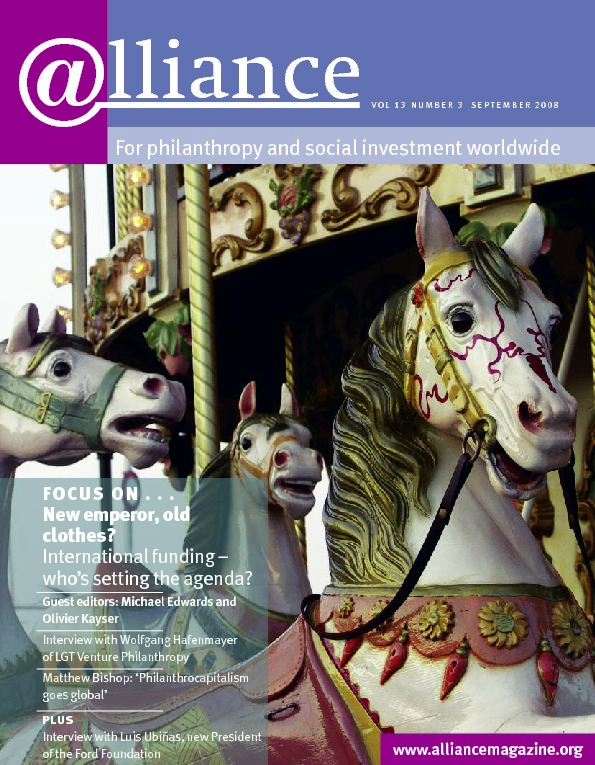 For the past two years I have been assisting the Global Fund for Community Foundations to consider whether it should establish itself as a free-standing entity. One of the more interesting aspects of this involvement has been the dialogue between the Global Fund and the World Bank’s Community Driven Development Initiative, the major supporter of the Global Fund. While the World Bank, to its credit, has deemed it worthwhile to test the utility of community foundations as a vehicle for community-driven development, that is by no means a common occurrence.
For the past two years I have been assisting the Global Fund for Community Foundations to consider whether it should establish itself as a free-standing entity. One of the more interesting aspects of this involvement has been the dialogue between the Global Fund and the World Bank’s Community Driven Development Initiative, the major supporter of the Global Fund. While the World Bank, to its credit, has deemed it worthwhile to test the utility of community foundations as a vehicle for community-driven development, that is by no means a common occurrence.
It has always struck me as peculiar that development professionals – in government development agencies, multilateral institutions, international NGOs – and community foundation practitioners seem to live in parallel universes. At any gathering of development experts, there is much discussion about appropriate institutions to bring forward and sustain the development process, yet community foundations seldom get a mention. Here I am defining development as progress on a cluster of variables that collectively measure the quality of life. We can argue about the specific variables to include, but the aim is to try to ascertain what makes people’s lives more rewarding.
While development professionals seldom mention community foundations, community foundation practitioners are hardly pounding on the doors of development conferences. Instead, they seem to have been engaged in internecine strife. In the US, where half the world’s community foundations are located, practitioners are finally emerging from a long, protracted, and basically fruitless argument about whether their stakeholders are the community they serve or the donors that give them the resources to serve these communities. Why is it so hard to agree that both are stakeholders and move on?
Outside the US, where growth in the number of community foundations in some countries is blistering, the focus on community has stayed more central. Rather, the debate has been on whether poor local communities have the resources to start, let alone sustain, community foundations. This debate has raged alongside one about the appropriate role, if any, for foreign resources in starting and sustaining community foundations. The answer, as we are learning, seems to be that there are untapped resources in the poorest of communities and that foreign resources can play a legitimate role as catalyst and sustainer if the leadership of the foundation is seen as ‘of the community’.
If the community foundations and the development community are like ‘strangers in the night’, then it is about time they got together and went out on a date. Any matchmaker worth his or her salt would see at once that they have a good number of things in common. First, community foundations usually encompass a manageable geographic area, and in-depth understanding of a well-defined geographic area is a basic necessity for grassroots-driven development. Add to this three other attributes of community foundations and the fit with development seems almost too good to be true. Community foundations are in a sense owned by their communities, their leadership is drawn from these communities, and their priorities are set by the communities and not imposed from outside.
But perhaps it is a fifth attribute that is most compelling. We are bombarded today by venture philanthropists claiming that one big difference between them and old-style traditional philanthropy is that they go into their initiatives with a built-in exit strategy. This helps reduce dependency and getting mired in the bog of continuing to throw resources at efforts that are not sustainable. This is not the place to debate the merits of venture philanthropy directly, but it’s worth pointing out that community foundations can be intermediaries in the development process with that very precious attribute – a built-in exit strategy.
We all, in traditional philanthropy, venture philanthropy and development, fear creating dependency and being trapped supporting unsustainable efforts. Community foundations, almost by definition, aim to attain a level of self-sufficiency by generating resources from within their communities. They do this to ensure that the foundation will be led by community leaders, owned by the community, and have its priorities set by the community. Were development experts to understand community foundations better, a whole new flow of resources could be channelled to them. That’s what I call a date with a great outcome!
Barry D Gaberman can be contacted at bgaberman@gmail.com
The Trustees’ column will be back in the December issue of Alliance.






Comments (0)